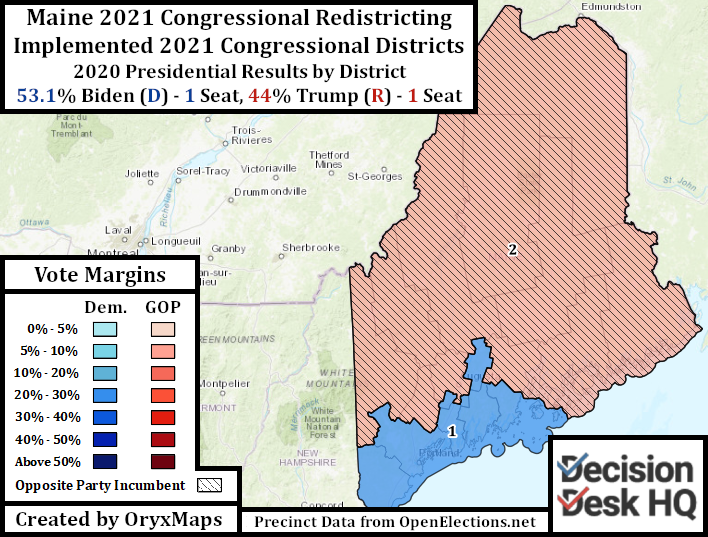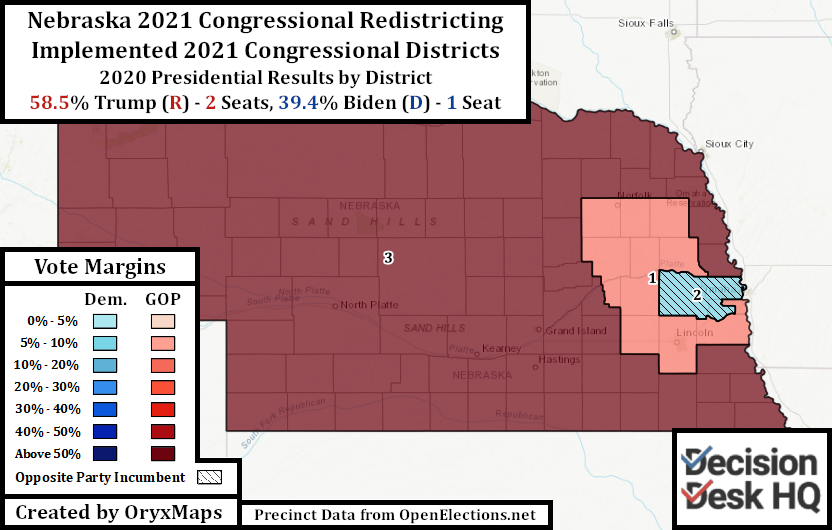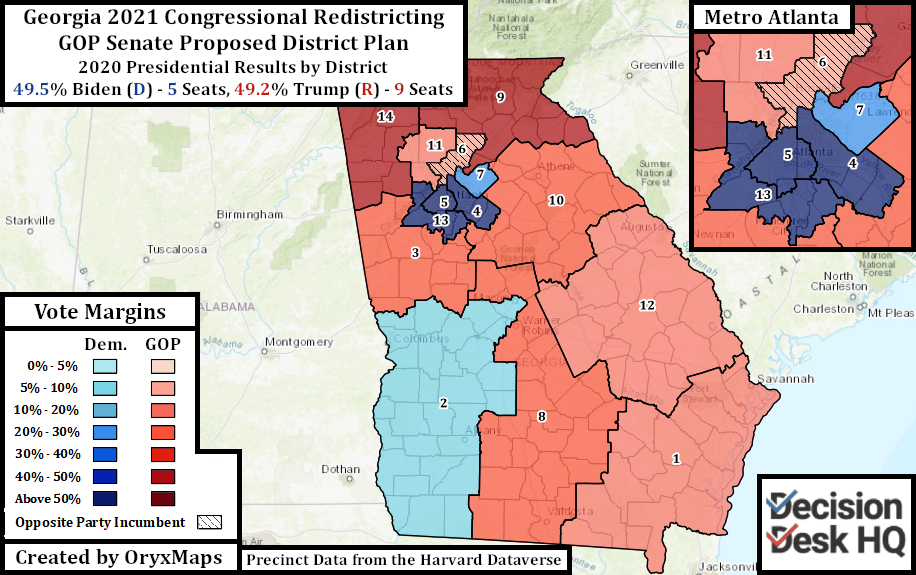Three states completed their formal mapping processes in the two weeks since Decision Desk HQ last examined redistricting. Even more states began their process by publishing preliminary maps or proposals. State legislatures have sole power over redistricting in all five states examined today and in each state the party that controls the legislature chose protection of its incumbents over pure partisan gain.
Oregon
Decision Desk HQ first covered Oregon redistricting September 10th after Beaver State Democrats and Republicans each proposed their own maps. Democrats control Oregon’s state government and they advanced a congressional gerrymander that would reliably elect five Democrats and one Republican.
Republicans have enough seats in Oregon’s House of Representatives to deny the body a quorum by refusing to show up for legislative session. If the state government did not pass maps before September 28th, it would cede power over redistricting. Congressional lines would hypothetically be drawn by a panel of judges selected by the State Supreme Court. Legislative district lines would be drawn by Democratic Secretary of State Shemia Fagan.
Democrats publicized that if this scenario occurred, Fagan would draw a worse legislative gerrymander than that proposed by the State Senate. Legislative Republicans acquiesced and gave the State House a quorum to pass and implement the Democratic maps.

Democrats made some changes to their maps to mollify Republicans. Legislative lines changed from the initial proposal in a few areas, and the final lines can be viewed here.
Democrats similarly changed their proposed Congressional districts so that one of the suburban seats is now only marginally Democratic. This adjustment however helps Democratic incumbent Kurt Schrader when compared to the incumbent’s previously proposed district. Schrader frequently disagrees with the Biden administration. Many local Democrats now wish to remove Schrader through the Democratic primary. Schrader has represented a marginal district for thirteen years and is familiar with tight races, so reducing the number of partisan Portland Democrats in his district improves his chances of winning both re-nomination and re-election.
Maine & Nebraska
Maine and Nebraska are the only states that allocate their electoral votes by Congressional district. Trump won Maine’s Second District and Biden won Nebraska’s Second District – despite the opposite candidate carrying the state overall. Both districts re-elected Congressional incumbents from the opposite party that the district voted for presidentially. Maine Democrats and Nebraska Republicans had every incentive to gerrymander these two seats.
The minority parties votes were needed in both states to successfully redistrict, preventing any gerrymanders. In Nebraska, Democrats had the numbers to filibuster Republican maps and, in Maine, maps must be approved by a two-thirds majority of the state legislature. Decision Desk HQ previously examined Republican attempts to gerrymander NE-02 by dividing Omaha. That map did not pass the legislature.

Maine Democrats and Nebraska Republicans could only pass their maps if NE-02 and ME-02 remained competitive. Both parties in both states however did make their incumbents marginally safer. ME-02 gains the city of Augusta and goes from a district Trump won by 7.4% to one he carried by 6.1%. NE-02 loses Democrat-trending suburban areas outside of Omaha in Sarpy County and gains Republicans from adjacent rural Saunders County. The district goes from one Biden won by 6.6% to one he carried by 6.% with a lower overall Democratic ceiling.

Maine’s maps were approved and implemented on September 29th. Nebraska’s maps cleared all necessary legislative votes and were signed into law by the Governor on Thursday September 30th. Both states passed legislative maps with their congressional plans. Nebraska’s single legislative map can be viewed here, and Maine’s new legislative lines can be viewed here.
Georgia
Georgia’s first congressional plan – released September 27th – is designed to protect incumbents, but Georgia is not guaranteed to keep this preliminary plan released by the Lieutenant Governor and the Senate GOP. More Congressional proposals will be released in the coming months.

Georgia’s first plan is designed to protect Republican incumbents with little change to their districts, but it partially fails at that objective. Under this plan, 11th District Republican incumbent Barry Laudermilk resides in the 14th District, and 9th District Republican incumbent Andrew Clyde resides in the 10th District.
Republicans attempted to draw Sixth District Democratic incumbent Lucy McBath into a Republican seat. They did this by adding Democratic parts of the former district into the four other Atlanta Democratic seats, transforming the Seventh District into a new safe Democratic seat. The Republican areas dropped by GA-07, such as Forsyth County, now sit in the new GA-06. GA-11 gathers several Cobb County Democratic areas previously in GA-06, though this makes GA-11 a potential Democratic target after several years of Atlanta growth. The proposed GA-06 is overall marginally Republican under 2020 numbers, but it remains a competitive seat and, because of Atlanta’s Political trend, it is a seat the Democrats will likely win in future elections under these lines.
The first plan’s lines are preliminary, and if kept will likely change to shore up the incumbents dislocated from their seats. If this becomes the final map, a voting rights lawsuit is likely. The southwestern second district is plurality African American, a retrogression from the current lines. The district will need to lose counties with majority white populations and gain rural African American counties to the east of Macon. There are also currently three African American majority districts in the Atlanta metro. One could potentially draw four African American seats in the region without touching the diverse GA-07 in Gwinnett County.
Texas
Texas Republicans gradually released their proposed maps over the past two weeks. The overall proposals indicate that the Texas GOP is concerned by the population growth and massive Democratic swings emerging in the state’s suburbs.
Texas’s Republican-drawn Congressional plan nearly collapsed in 2020. Redrawing the districts to protect vulnerable Congressional incumbents was the aim of Republican mappers, any other gains would be a bonus. The most gerrymandered parts of the Republican plans all occur in the Dallas-Fort Worth Metroplex where the Democratic party improved the most in 2020.

Texas gained two Congressional districts through 2020 reapportionment. One district went into Austin, which the GOP previously divided between five Republican districts in 2010. All five ended up as marginal races by 2020. This new Democratic district releases pressure on the five seats allowing them to absorb Democratic voters from other parts of the state. The second new Congressional seat is roughly the successor to the old Seventh district in west Houston, with the new TX-07 traveling between Houston and her suburbs as a new, safe Democratic seat.
TX-03, TX-06, TX-07, TX-10, TX-21, TX-22, TX-23, TX-24, TX-25, TX31, and TX-32 were all potential competitive seats in 2020. TX-15, TX-28, and TX-34 became competitive because of newfound Republican strength among South Texas Hispanics. All but one of the districts are now uncompetitive. Republican Districts gain more Republican voters, and the few Democratic held seats become more Democratic. All of the former Republican suburban seats reach deep into the rural and exurban areas and drop Democratic suburbs. Former rural and exurban seats – TX-04, TX-05, TX-08, TX-13, and TX-36 – reach deeper into the suburbs to carve up Democratic areas. The result is districts with obtuse borders where the Democrats gained the most voters, such as the north Dallas suburbs with the new TX-04.

In South Texas, past voting rights litigation prevents Republican map-makers from exploiting recent party gains. The resulting districts resemble the present lines and stretch northwards, but the most GOP-favoring Hispanic areas are now congregated in TX-15 which makes it a potential swing district. O’Rourke did win this seat by over 10%, so the district will not be competitive if the 2020 results end up as a one-off occurrence.
Texas mappers still found ways to cater to their protected incumbents. In TX-10, Senior Republican Michael McCaul gets a district that squiggles narrowly around Austin from his neighborhood west of the city to rural Texas. New TX-06 Republican Jake Ellzey’s district takes in more rural areas where he is better known and loses Arlington Republican voters who backed Susan Wright during the 2021 Special Election. TX-25 previously did not include Republican Roger Williams’ base in Weatherford, west of Fort Worth. Now it does.
Republicans also released their proposed Legislative and Board of Education district maps, which can be viewed here. Biden in 2020 and O’Rourke in 2018 won a majority or a near-majority of districts on the former maps for these bodies, so Republican mappers were even more desperate to gerrymander these lines. Both maps protect incumbents in a similar manner to the Congressional plan with the rural and exurban areas reaching into the suburbs. The legislative plans however go beyond incumbent protection and each attempt to carve up a marginally Democratic seat in the Dallas-Fort Worth Metroplex.
The desire to protect incumbents may end up dooming State House Republicans in future years. County nesting requirements prevented the GOP from linking the Republican dominated rural areas to the suburbs. By giving former Biden-District Republicans seats Trump won, other, formerly safe Republican seats needed to take in Democratic voters. Even more districts than previously become marginal districts that could potentially swing heavily away from the GOP.
Voting rights litigation is a constant factor in Texas redistricting. For example, plaintiffs forced Texas Republicans to draw the new Dallas-based TX-33 into a Hispanic Democratic seat in 2010 (initial 2010 map here). This new Congressional gerrymander disadvantages minority communities across the state, especially since nearly all of Texas’s recent growth came from minority groups. The proposed TX-23 is only 60% Hispanic compared to the 80% or higher in other South Texas seats, limiting minority opportunity. TX-27 has several majority Hispanic counties, including the city of Corpus Christi, inside a seat where White voters historically pick the representative. TX-38 could be a second, overwhelmingly Hispanic seat in the Houston area. TX-18 was previously an African American district, but is here majority Hispanic, an example of regression. Fort Worth minority voters are distributed between four Districts and there could be a fourth minority seat in the region. A majority-minority coalition seat can be drawn in the suburbs north of Dallas. Expect this criticism and more to potentially be levied in future court cases.
Miscellaneous Updates
Arkansas: Decision Desk HQ previously analyzed three Arkansas Congressional proposals that preserved the composition of Arkansas’ four Congressional Districts. Fifteen more legislators have put forward maps since then. Each map’s specific contours can be found here. The Legislature reconvened on Wednesday to begin selective elimination.
Colorado: The Colorado Redistricting Commission put forward many preliminary proposals previously covered by Decision Desk HQ. After several hours of debate and many rounds of voting, the Commission agreed to an initial final proposal. This map can be viewed here. Redistricting is not done; the maps now go before the Colorado Supreme Court which can approve or reject with guidance on how to improve the proposal. Rejection appears likely given Colorado’s strict constitutional language around minority community access and how multiple commissioners disagreed with this map on ‘community of interest’ grounds – prompting the tense late-night debate.
Indiana: Decision Desk HQ previously covered Indiana’s State House and Congressional proposals. The Indiana GOP has since unveiled their State Senate map. Final approval is expected on Friday, October 1st.
Michigan: The Michigan Redistricting Commission spent the past several weeks debating and drawing districts in full view of the public through a YouTube livestream. Proposed drafts for both legislative and Congressional lines are nearing completion, at which point they will become the focus for a new round of public forums and inquiry.
North Dakota: North Dakota lawmakers unveiled their proposed legislative lines. The map moves districts from shrinking rural areas to the booming, oil-producing west, and can be viewed here. The legislative committee approved the map, but cannot be voted upon until the Legislature reconvenes in November.
New Mexico: New Mexico’s Redistricting Committee released many maps they have received or previously drafted as concepts for future lines. On October 15th the Committee will use the submitted concepts to present three proposals for Congressional and legislative lines. This committee is advisory and the legislature can reject its findings and draw the lines itself after convening this winter.
Ohio: The ACLU and several other groups sued Ohio Redistricting Commission over the State’s new Legislative maps. Decision Desk HQ noted in our analysis of the legislative gerrymanders that this was likely to occur and, because of Republican Chief Justice Maureen O’Conner’s opposition to partisan gerrymanders, the court potentially has a majority in favor of the plaintiffs. If the court strikes down the Legislative maps, the commission will have to reconvene and draw new lines under court supervision.
Virginia: Consultants working for the Virginia Redistricting Commission released competing proposals for both chambers of the State Legislature. After releasing these proposals, the commission ordered further refinement and a second set of maps. The new maps can be viewed here.
Washington: Washington has a four-member Redistricting Commission with each member appointed by the leader of a legislative chamber’s caucus. Each commissioner released their own proposal for the state’s Legislative and Congressional lines, which can be viewed here. 2010 Evergreen State history tells us that these maps are starting points with the four-member body agreeing to proposals built from these initial plans.
West Virginia: The West Virginia Legislature has released multiple proposals for the state’s congressional lines. The Mountain State loses one of it’s three Congressional districts. The central WV-02 district is cut in most proposals. WV-02 is the easiest to dismantle geographically and partially because Republican incumbent Alex Mooney has few friends in the West Virginia legislature after carpetbagging from the Maryland Legislature. Mooney remains unpopular and has at times significantly underperformed all other West Virginia Republicans. A potential State House map was also released. The proposed maps can be viewed here.
Ben Lefkowitz (@OryxMaps) is a Contributor to Decision Desk HQ.
This analysis of congressional redistricting was written before Benjamin Lefkowitz started work for the Lawyers’ Committee for Civil Rights. All views, opinions, and analyses are those of the author and no other organization.